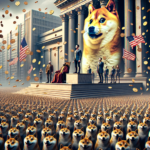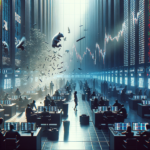Implications of X.com’s Decision to Halt NFT Profile Integration
Elon Musk’s X.com, the enigmatic online platform that has been a subject of much speculation since its acquisition by the tech mogul, has recently made headlines with its decision to cease the integration of non-fungible token (NFT) profile photos. This move, while unexpected, signals a significant shift in the platform’s approach to digital identity and ownership, and it has far-reaching implications for the burgeoning NFT market.
The integration of NFTs into social media profiles had been hailed as a major step forward for digital artists and collectors, providing a new way to display and authenticate ownership of unique digital assets. However, X.com’s pivot away from this feature suggests a reevaluation of the value proposition that NFTs offer to social platforms and their users. Despite this, the platform’s decision is not necessarily a setback for the NFT community; rather, it could be seen as an opportunity to reassess and innovate within the space.
X.com’s move away from NFT profile photos may be indicative of a broader trend towards a more nuanced understanding of digital identity. In a world where online presence is increasingly important, the question of how to represent oneself digitally has become more complex. The initial excitement around NFTs as a means of self-expression and verification on social media is now giving way to a more critical examination of their practicality and inclusivity.
Moreover, the decision by X.com could encourage a healthier digital ecosystem by prompting other platforms and users to consider the implications of tying digital identity too closely to ownership of assets. The optimistic view is that this could lead to the development of new forms of digital representation that are more accessible and less tied to financial investment, thereby democratizing the digital space.
For the NFT market, X.com’s decision is a reminder that the industry is still in its infancy and must remain adaptable. The market has seen incredible growth and innovation in recent years, but it has also faced criticism over issues such as environmental impact, market volatility, and the potential for exclusivity. By stepping back from NFT profile integration, X.com may be encouraging the market to address these concerns and to find new ways to create value for users.
The optimistic tone surrounding this development is rooted in the belief that innovation often arises from change and challenge. As X.com rethinks its approach to digital identity, it may inspire others to do the same, leading to a more diverse and resilient digital landscape. The NFT community, known for its creativity and adaptability, is likely to respond with fresh ideas and applications for NFT technology that go beyond profile pictures.
In conclusion, while the cessation of NFT profile photo functionality on X.com may seem like a step back for the integration of NFTs into mainstream social media, it opens the door to a broader conversation about digital identity and ownership. This decision could lead to more inclusive and innovative ways of representing oneself online, and it challenges the NFT market to evolve and address its shortcomings. In the ever-changing digital world, X.com’s move may be just the catalyst needed for the next wave of digital innovation.
How Elon Musk’s X.com Pullback Affects the NFT Market Landscape
Elon Musk’s X.com Pullback Affects the NFT Market Landscape
In a surprising turn of events, Elon Musk’s ambitious venture X.com has announced the cessation of its NFT profile photo functionality, a feature that allowed users to flaunt their digital art ownership. This move, while unexpected, sheds light on the evolving dynamics of the non-fungible token (NFT) market and its intersection with mainstream social platforms.
X.com, initially acquired by Musk in the late 90s and recently reimagined as a multi-faceted tech platform, had embraced the burgeoning NFT craze by integrating a system where users could link their digital wallets and display their NFTs as profile pictures. This integration was seen as a significant endorsement for the NFT community, providing a bridge between the niche market of digital collectibles and the broader social media landscape.
However, the recent decision to roll back this feature has not dampened the spirits of NFT enthusiasts. Instead, it has sparked a conversation about the sustainability and practicality of NFTs within the digital ecosystem. The move by X.com is indicative of the platform’s commitment to adaptability and responsiveness to the market’s needs and challenges.
Despite the pullback, the NFT market continues to thrive, with new projects and collaborations emerging at a rapid pace. The market has shown resilience in the face of volatility, with creators and collectors alike finding innovative ways to leverage blockchain technology for artistic expression and investment.
Moreover, the withdrawal of NFT functionality from X.com does not signify a lack of faith in the technology or its potential. On the contrary, it highlights the importance of strategic integration and the need for platforms to carefully consider how features align with their user experience and core values. Musk’s decision can be seen as a recalibration rather than a retreat, ensuring that any future forays into NFTs or related technologies are well thought out and executed.
The NFT landscape is still in its infancy, and the journey is far from over. The market is learning to navigate the complex web of intellectual property rights, authenticity, and the environmental impact of blockchain technology. As these conversations continue, platforms like X.com play a crucial role in shaping the discourse and setting industry standards.
Furthermore, the pullback has not stifled innovation within the NFT space. Artists, developers, and entrepreneurs are continually pushing the boundaries of what’s possible, exploring new use cases for NFTs beyond profile pictures, such as virtual real estate, gaming assets, and even tokenized physical objects.
The optimism surrounding the NFT market is palpable, with many seeing Musk’s move as a mere hiccup in an otherwise upward trajectory. The industry is poised for growth, with the potential to revolutionize not just art and collectibles, but also sectors like entertainment, fashion, and real estate.
In conclusion, while X.com’s discontinuation of NFT profile photo functionality may seem like a setback, it is, in fact, a testament to the platform’s agility and foresight. The NFT market remains a hotbed of creativity and innovation, with stakeholders eagerly anticipating the next chapter in its evolution. As the landscape continues to mature, it is clear that the integration of NFTs into mainstream platforms will be a nuanced and deliberate process, one that balances the excitement of new technology with the practical considerations of user experience and market stability.







